What are caterpillars?
Caterpillars are the larvae of butterflies and moths. Butterflies and moths form the order Lepidoptera, a very large group with more than 150,000 species, that are easily distinguishable from other insects.Caterpillars can cause serious economic damage. Most species feed on leaves and young shoots, and their enormous feeding capacity can rapidly decimate a plant. Very small caterpillars are not able to chew and therefore graze the underside of leaves. This causes a window effect where the epidermis of the upper leaf surface remains undamaged. Young caterpillars are often found in groups, spreading out over the plant as they grow larger.
Many of these caterpillars are most obvious when they’re fully grown and looking for a place to either pupate or settle down for the winter, though some are easily spotted on their favourite food plants. Here are some of the yellow species of caterpillars that are frequently found in woodland, open countryside and urban gardens and parks:
- Yellow Woolly Bear (Spilosoma virginica)
- Buff-Tip Moth Caterpillar
- Sycamore Tussock Caterpillar (Halysidota harrisii)
- American Dagger Caterpillar (Acronicta americana)
- Sycamore Moth (Acronicta aceris)
- Cloudless Sulfur (Phoebis sennae)
- Six-Spot Burnet (Zygaena filipendulae)
- Tasar Silkworm Caterpillar (Antheraea mylitta)
- Pale Tussock (Calliteara pudibunda)
- Giant Peacock Moth Caterpillar (Saturnia pyri)
- Sawfly caterpillars
- Cinnabar Moth Caterpillars
- Magpie Moth Caterpillar
- Large White Caterpillar
- Saltmarsh Caterpillar
Yellow Caterpillars
Yellow Woolly Bear Caterpillar

Caterpillars of yellow woollybear are densely hairy and pale colored ranging from light brown to yellow to nearly white uniformly dispersed over the entire body. The head is not separately colored nor are there any tufts of different colors.
The caterpillars of yellow woolly bear moths are seen more often than the adults, which fly during the night. The adults have a few small dark spots on their white wings and white and orange abdomens. The caterpillars occur in the fall and overwinter as pupae in cocoons attached to leaves. Woollybear eats most of the plants grown in the garden as well as many species of ground cover found many landscape.
Also Read: Different Types of Striped Caterpillars
Buff-Tip Moth Caterpillar

The fully grown caterpillar is up to 75mm in length and has a distinctive trellised yellow and black patterning with a covering of fine pale hairs.Their black and yellow colouration serves to warn predators that they are distasteful, and their hairs cause irritation to anything trying to swallow them.
The large yellow and black caterpillars of this moth feed in groups and can consume large areas of foliage on a wide range of shrubs and trees. They are frequently found in woodland, open countryside and urban gardens and parks.
Sycamore moth caterpillar (Actronicta aceris)
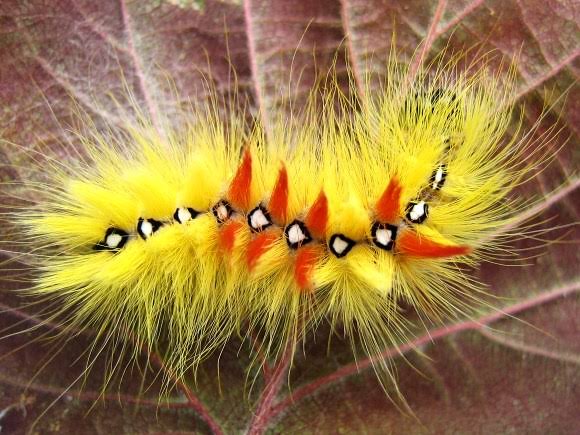
The fully grown, brightly coloured, hairy caterpillars are commonly seen in late summer and early Autumn when they leave the trees to wander in search of somewhere to pupate. They feed on a variety of deciduous trees including sycamore and maples.They are well known for dropping out of trees and on occasions landing on walkers.
The caterpillars are frequently found in urban and rural areas where the larval foodplant of Sycamore and London Plane trees occur. As with all hairy caterpillars care should be taken if handling as the hairs may cause irritation to the skin.
Sycamore Tussock Caterpillar (Halysidota harrisii)
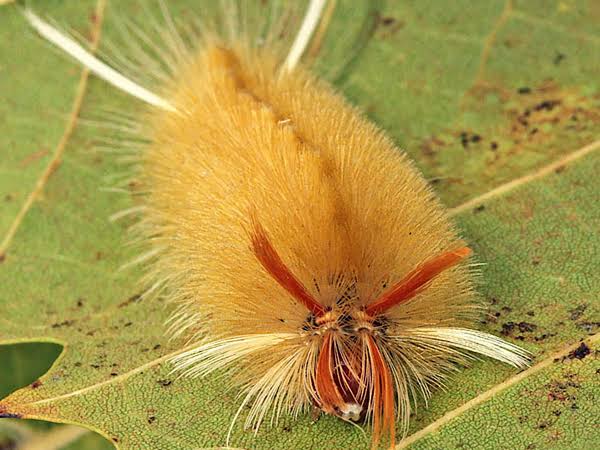
The Sycamore Tussock caterpillars have yellow-orange heads and bodies covered with hair, and they can grow to approximately 25–35 mm in length. They exhibit two pairs of long, orange hair-pencils and two pairs of white hair-pencils towards the front of their body. They also exhibit one pair of white hair-pencils near the back of their body.
The Sycamore tussock caterpillar looks identical to the banded tussock caterpillar species, (Halysidota tessellaris), but the latter species’ habitat is mostly limited to forested areas where they do not pose a threat to residents. Both of these species possess white or light-brown-colored hairs with orange tufts behind their heads, making them easy to spot. They feed on milkweed and a variety of deciduous trees including sycamore and maples.
These caterpillars remain in their cocoons all season long, protecting them from the elements. They emerge as flying adults the next spring and parent the first generation of the new year. As with all hairy caterpillars care should be taken if handling as the hairs may cause irritation to the skin.
American Dagger Caterpillar

Dagger moth caterpillars are fuzzy with medium length yellow, yellowgreen, or even white setae. They also have four, elegant, slender, black “pencils” of setae that extend out from the first and third abdominal segments. A fifth pencil of black bristles extends near the rear of the caterpillar. It is reputed that these pencils may break off and become embed into skin.
The dagger moth caterpillars feed on the leaves of alder, ash, elm, maple, oak, willow, and other hardwood trees in yards, parks, backyards, forests and woodlands throughout the growing period.
Cloudless Sulfur Caterpillar

Cloudless Sulfur caterpillars are usually of variable Color: They may be green with a bright yellow stripe; green with a bright yellow stripe and blue patches on the sides; yellow with bright yellow line on sides; yellow with bright yellow line on sides and black rings. All have varying degrees of short hairs that come from tiny black tubercles.
The cloudless caterpillar forms a chrysalis that is pointed at both ends and humped in the middle. The chrysalis will be either yellow or green with pink or green stripes. From the chrysalis comes a medium-sized butterfly (55–70 mm) with fairly elongated but not angled wings.
Six-spotted Burnet Caterpillar
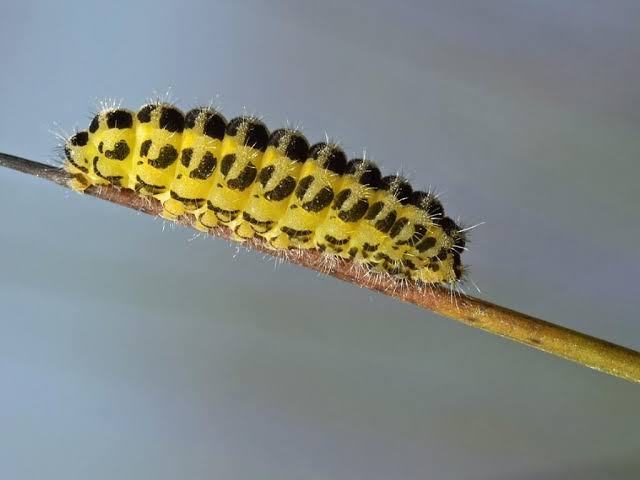
The identification features of the six-spotted burnet caterpillar are its bright yellow body, black markings along its back, a light green stripe on its sides and thin spiny hairs. Their black and yellow colouration serves to warn predators that they are distasteful, and their hairs cause irritation to anything trying to swallow them. They’re found in woodlands and on the edges of swamps, browsing on poplar, willow, alder, basswood, maple, and oak leaves.
Tasar Silkworm Caterpillar

Tasar Silkworm caterpillars are green colored with paired dorsal series of yellow humps. White lunulate spots on the fifth and sixth somites have purple borders, whereas a lateral yellow line from seventh somite ends in a dilated brown band on the anal somite. Spiracles are yellow. The cocoon is brownish grey, hard, and oval, attached to the host plant by a silken peduncle.
Also Read: Types of Green Caterpillars
Pale Tussock Caterpillar
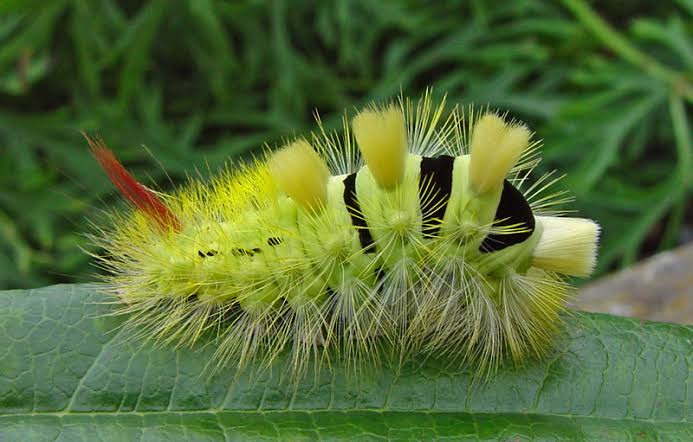
Pale Tussock Caterpillar are usually between 40-45mm in length. They are often light lemon yellow, but sometimes brownish yellow, violet or blackish grey, with deep black segmental incisions, lighter dorsal brushes and red or brown pencil on the 10th segment. They are found in a wide variety of habitats including gardens, woodlands and along countryside hedgerows. These Caterpillars feed on a wide variety of deciduous trees as well as many other plants such as bramble, willow, oak, beech and hops.
Giant Peacock Moth Caterpillar
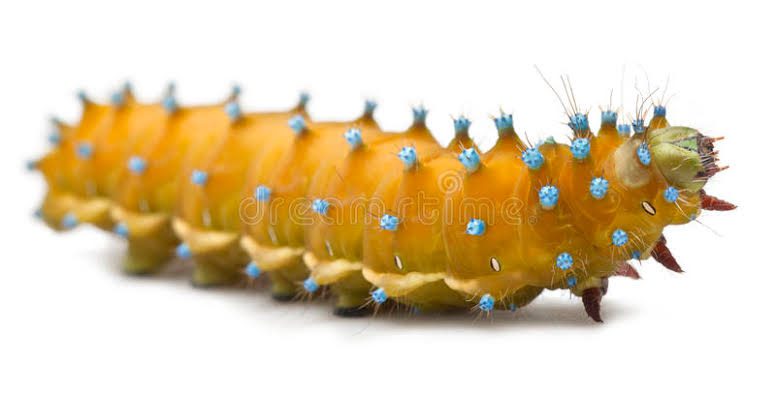
Giant Peacock Moth Caterpillar is a large golden-green caterpillar with darker orange bands around the middle of the segments and turquoise-blue tubercles and tiny irritating hairs. It’s found in a wide range of habitats including open woodlands, moorland, valleys and urban gardens. The caterpillars feed on a wide range of deciduous trees such as blackthorn, hawthorn, apple and oak as well as various garden plants including rose and blueberry bushes.
Cinnabar moth caterpillar
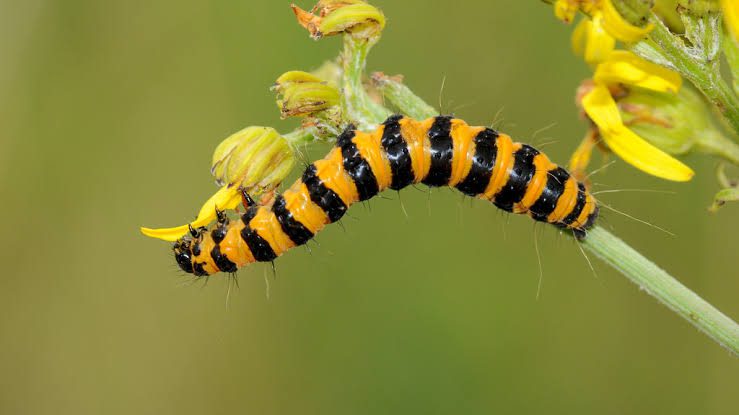
These caterpillars grow up to 28 mm and are distinguishable due to their jet black and yellow/orange stripes. They are voracious eaters and can be seen decimating their favourite food plant – ragwort – possibly reducing the plant to mere stems in some cases. These caterpillars can be seen in open places, well drained grassland, sand dunes, woodland rides and in gardens.
The adults fly from May to early August, and caterpillars are feeding throughout July to early September. Hibernation is in the pupa stage and the cocoon is made on or under the ground near to the food source.
Magpie Moth Caterpillars

The distinctive Magpie Moth caterpillar is between 28-30 mm in length with a creamy white body, rows of black and white spots and an orange spiracular stripe.The caterpillars overwinter when small, becoming fully grown by late Spring. Fodplants for these caterpillars include a wide range of deciduous trees including blackthorn, hawthorn, hazel and spindle. The caterpillars are also frequently found feeding on current and gooseberry bushes.
These caterpillars may also be found hanging on silken threads from bushes and trees during the day. They are sometimes known as the looper because of the tight loops it makes when crawling. Although its bright colouration makes it easy to spot, it also serves to warn predators that it is unpleasant to eat.
Large White Caterpillars

Large White Caterpillars are often referred to as the Cabbage White because its caterpillars feed on crucifers, members of the Brassicae family of vegetables, and can be a pest to both commercial farmers and garden vegetable growers.
Large White caterpillars grow up to 45mm and are a distinctive mix of black, grey and yellow. They give off a mustardy smell which combined with their bold colouring acts as a warning to predators. When fully grown after about four weeks the caterpillars stop feeding and leave the food plant to look for a suitable place to pupate.
Saltmarsh Caterpillar

Saltmarsh caterpillars are densely hairy and can be a variety of colors. When young, these caterpillars appear more yellowish. As the caterpillar ages they darken and can be anywhere from orange in color to black. Indistinct striping can be seen along the caterpillar.The thoracic and abdominal segments have a few rows of orange or black warts, and it has one tiny white dot per segment, on both sides of its body.
The saltmarsh caterpillar survives winter as a full grown larva within a cocoon, hidden amongst leaves and other debris on the soil.The cocoon from the saltmarsh caterpillar is formed from the interwoven body hairs and is a thin cocoon. Pupation occurs in spring and the adults emerge in late spring.
Saltmarsh caterpillars skeletonize the plants they feed on, leaving only the main leaf veins. Older caterpillars eat large holes in the leaves and become more solitary. They can go great distances in search for food and can sometimes travel in large numbers.
Further References
- Types of Caterpillars: https://www.orkin.com/pests/types-of-caterpillars
- Caterpillars: https://sfyl.ifas.ufl.edu/wakulla/natural-resources/big-bend-bugs/caterpillars/
- Comparative Study on Caterpillars: https://www.researchgate.net/publication/296658123_Caterpillars
- Caterpillars as Social Insects: https://www.researchgate.net/publication/238029535_Caterpillars_as_Social_Insects
- Facts about Caterpillars: https://study.com/academy/lesson/facts-about-caterpillars-lesson-for-kids.html